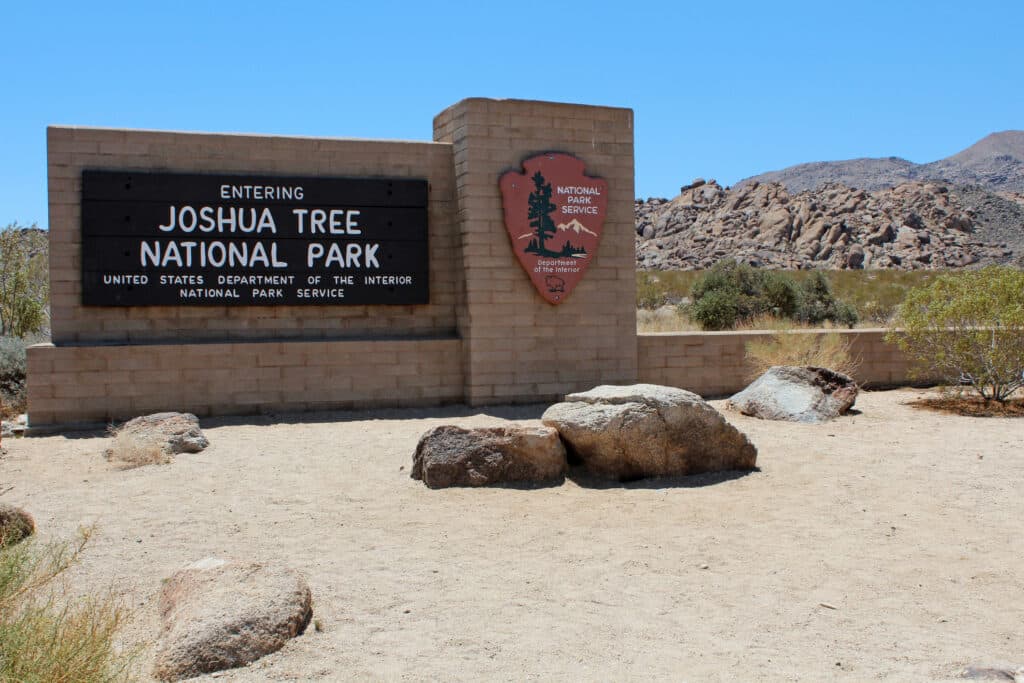
As of 2025, Joshua Tree National Park charges a $30 entrance fee per vehicle (valid for 7 days). Motorcyclists pay $25 for a week-long pass, and individuals entering on foot or bicycle pay $15 per person (children under 16 are free). For frequent visitors, an Annual Park Pass costs $55 and covers a year of entries to Joshua Tree, while the interagency America the Beautiful pass (covering all U.S. national parks) is $80.
Certain groups enjoy special access: U.S. military veterans and Gold Star families, as well as all 4th-grade students, can obtain free national park passes, and seniors (age 62+) can purchase discounted annual or lifetime passes. The park itself is open 24 hours a day, 7 days a week, year-round, with no holiday closures – you can drive in or out at any time.
Note that visitor centers do observe regular hours (generally opening by 8:00 a.m. and closing around 5:00 p.m., with slightly shorter schedules during the summer heat). Seasonal changes affect some operations: during the hot summer (roughly June through August), a few campgrounds close certain loops and the popular 49 Palms Oasis Trail is off-limits due to extreme heat, and a strict fire ban is in place (no campfires or charcoal grilling from June 15 to Oct 1). In contrast, the cooler spring and fall months offer full access but draw larger crowds, especially on holiday weekends when the park may temporarily close entrance gates if parking fills up. We visited on 07 August 2025, and all figures were valid then.
About the Joshua Tree National Park
Have you ever wondered what makes this desert landscape so special? Joshua Tree National Park sits at the meeting point of two distinct deserts – the higher-elevation Mojave Desert and the lower Colorado Desert – resulting in an incredible diversity of ecosystems and scenery. The park spans nearly 800.000 acres of rugged terrain dotted with the iconic Joshua trees, which are whimsical, twisting yucca plants that early settlers thought looked like figures praying under the sky. Amid sprawling groves of these spiky trees, we found surreal geologic formations: heaps of monzogranite boulders stacked over centuries by erosion. We scrambled among smooth rock piles at Jumbo Rocks and marveled at balancing stones that seem ready to tip at any second (they won’t!). This unique interplay of flora, fauna, and geology is a big reason the area was first protected back in 1936 (originally as a National Monument, later designated a National Park in 1994).
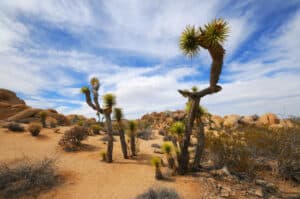
Joshua Tree National Park
Despite the harsh first impression of desert, Joshua Tree nurtures a rich variety of life. In fact, the park protects over 750 plant species, from cholla cacti and creosote bushes in the lower flats to juniper and pinyon pine woodlands up in the cooler highlands. Wildlife is mostly shy and nocturnal here – we learned to spot subtle signs like lizard tracks and burrows. By exploring quietly at dawn, we glimpsed a few desert cottontail rabbits foraging among the bushes and found fresh coyote paw prints by a sandy wash – clear evidence that these elusive predators were around. If you’re lucky(and patient), you might even encounter the endangered desert tortoise slowly crossing a road or a herd of bighorn sheep nibbling on scarce greenery. Birdlife adds splashes of color and sound too; we noticed red-tailed hawks soaring above and tiny hummingbirds flitting among blossoming ocotillo. This meeting of two deserts means you can find species from both ecosystems side by side – it’s kinda amazing to see brittlebush shrubs and fan palm oases thriving not far from each other.
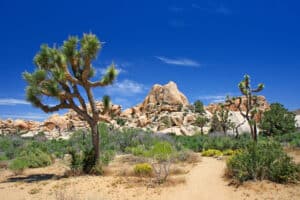
Joshua Tree NP
The park’s human history is equally fascinating. For thousands of years, Native American peoples like the Serrano and Cahuilla lived seasonally in this region, leaving behind petroglyphs and artifacts around the few water sources. In the 19th century, prospectors and ranchers arrived – you can still hike to old gold mines such as the Lost Horse Mine and see remnants of desert ranching at places like Keys Ranch (a historic homestead you can tour by reservation). Recognizing Joshua Tree’s natural and cultural value, activist Minerva Hoyt spearheaded the drive to protect it, leading to its national monument status. Today the park is not only a playground for outdoor enthusiasts but also a living laboratory for ecologists. Park scientists actively monitor challenges like invasive grasses that fuel wildfires and the impact of climate change on Joshua trees – some studies suggest Joshua Tree’s namesake trees could struggle to survive in a much hotter climate by the end of this century. In response, conservation efforts are underway, from habitat restoration projects to educational programs. (Did you know? The park is part of a UNESCO-recognized Mojave and Colorado Deserts Biosphere Reserve, highlighting it’s global ecological importance.) On a lighter note, Joshua Tree is famous for its dark night skies – the area has very little light pollution, making it an officially designated International Dark Sky Park. We spent one evening simply gazing up at thousands of stars; the Milky Way arched clearly overhead, making us feel wonderfully small.
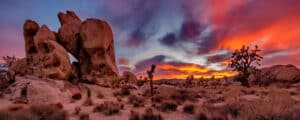
Joshua Tree National Park of California
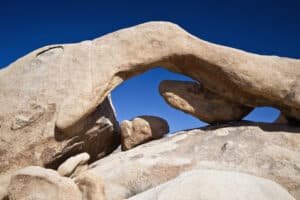
Arch Rock Joshua Tree National Park Rock
With so much to see, how long should you plan to visit? In our experience, a typical traveler can get a great overview in a full day: we dedicated one long day to driving the park’s main roads and taking short hikes at the major spots, and that felt very rewarding. However, if you love hiking, rock climbing, or photography, you might want 2–3 days or more – campers often stay several nights to catch both sunrise and sunset, plus the brilliant starlight. On average, many visitors seem to spend around 4 to 5 hours inside the park, often doing a quick drive-through, but we’d definitely recommend allowing more time if you can. There are dozens of trails (from easy nature walks to strenuous mountain climbs) and each reveals something different. Overall, Joshua Tree’s combination of accessible natural wonders and wild solitude left us with a deep appreciation for desert environments.
Nearby Sights and Food Options
During our trip, we discovered plenty of attractions both within the park and in the neighboring desert towns. Inside the park, beyond the main roadside stops, we found some lesser-known corners worth exploring:
-
Hidden Valley Trail – A lovely one-mile loop encircled by towering boulders, famed as a former cattle rustlers’ hideout. We walked this short trail in the late afternoon and enjoyed scrambling onto low rocks for fun. The area felt like a natural amphitheater hidden from the world.
-
Barker Dam – This historic water reservoir, built by ranchers over a century ago, created a small oasis. The loop trail (1.3 miles) led us past the old dam and past faint petroglyphs left by Indigenous people. We even saw few birds enjoying the remaining water – a real surprise in the desert.
-
Keys View – A high vantage point you can drive to on a spur road. We motored up just before sunset and were rewarded with a panoramic view stretching across the Coachella Valley; on a clear day you can see as far as the Salton Sea and distant Mount San Jacinto. It was a bit hazy for us, but the silhouette of far-off mountains was still gorgeous in the evening light.
-
Ryan Mountain – One morning we hiked this 3-mile (5 km) round-trip trail to the summit of Ryan Mountain (5,457 ft). It was a steep climb, but reaching the top gave us a 360° view of the entire park – absolutely worth the sweat. We started at 7 AM to beat the heat (we were gonna attempt another short trail afterward, but by 10 AM it was already scorching) and we’re glad we did.
-
Skull Rock – A quick, quirky stop along the main road where an oddly eroded boulder looks uncannily like a giant skull. It made for a fun photo op and a chance to stretch our legs. There’s also an easy loop trail around here, winding through jumbo boulders and sandy washes.
After immersing ourselves in Joshua Tree’s natural beauty, we also sampled the local culture and food just outside the park. The communities of Joshua Tree and Twentynine Palms lie at two of the park’s main entrances and each offered something special:
-
In Joshua Tree town, we started our day with breakfast at Crossroads Café, a beloved rustic diner known for its hearty portions. Their breakfast special called Mike’s Mess (a scramble of eggs, potatoes, veggies, and cheese all mixed up together) lived up to its name – not pretty, but delicious and filling! The laid-back, artsy vibe in the cafe made it a perfect spot to chat with locals before heading back into the park.
-
Over in Twentynine Palms, we treated ourselves to dinner at the 29 Palms Inn Restaurant. This historic inn sits by an actual desert oasis, and the restaurant uses herbs and vegetables from its own on-site garden. We ate on the patio under the stars, savoring a tender mesquite-grilled steak and a fresh salad sprinkled with pomegranate seeds. It was the ideal way to relax after a long hike – a cold local craft beer didn’t hurt either.
-
For a casual bite and drinks, we also tried Grnd Sqrl (short for “Ground Squirrel”) in Twentynine Palms. This hip gastropub served great craft beer and inventive pub food. We split a falafel burger and sweet potato fries which were honestly really good. After days of trail mix and granola bars on the trail, having a warm meal here was awesome.
-
Before leaving the area, we spent a Saturday morning browsing the Joshua Tree Farmers’ Market (held weekly along the highway). We picked up some home-baked date cookies and a jar of local cactus jelly as souvenirs. It was fun seeing the community’s creative side – market stalls offered everything from handmade ceramics to tie-dye shirts.
Exploring these nearby sights and stops really rounded out our Joshua Tree experience. We hiked, we climbed, and we ate like hungry desert explorers. At the end of our trip, we left Joshua Tree with dusty boots, mild sunburns, and a newfound appreciation for how alive the desert can be.
Sorry, there were no items that matched your criteria.

